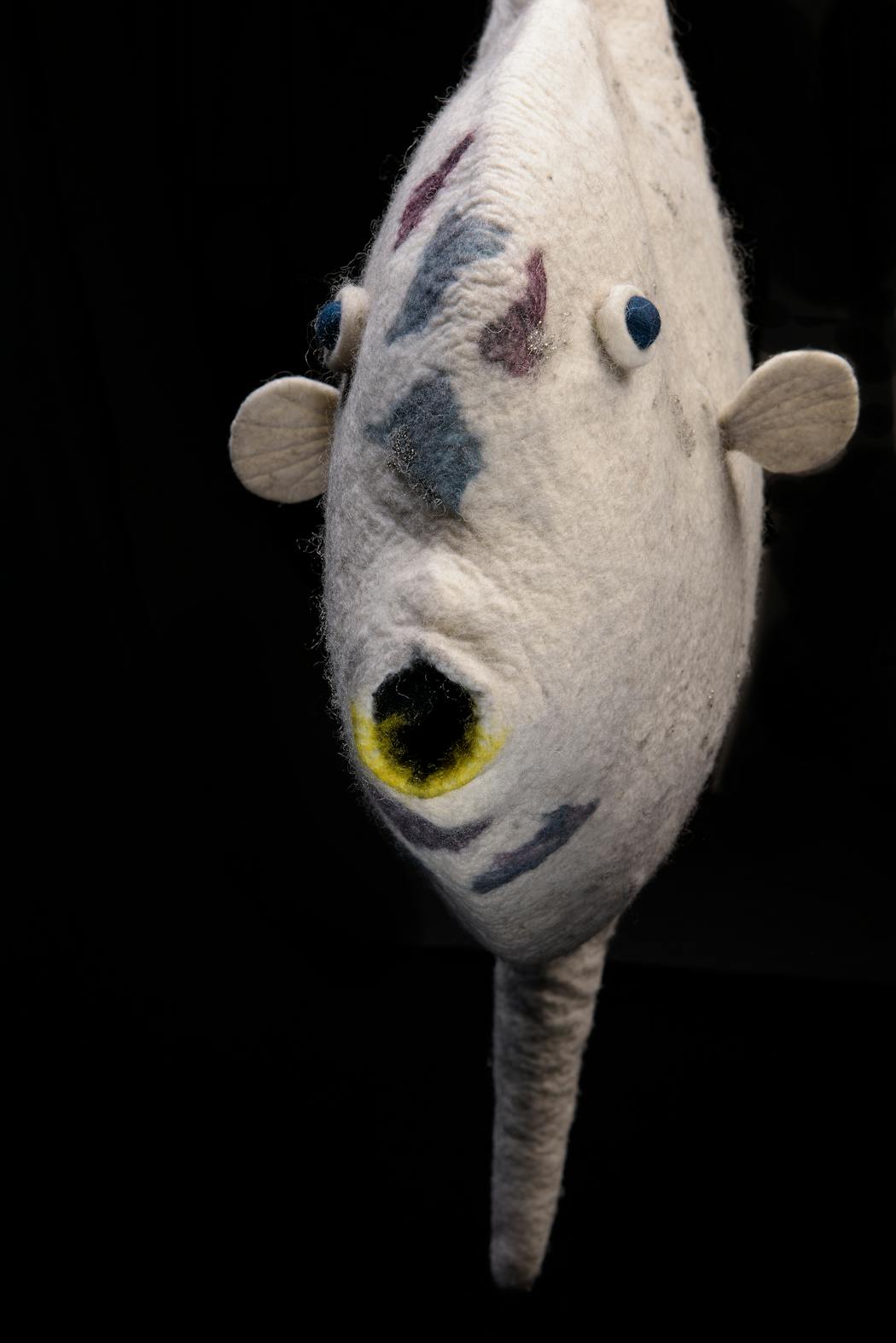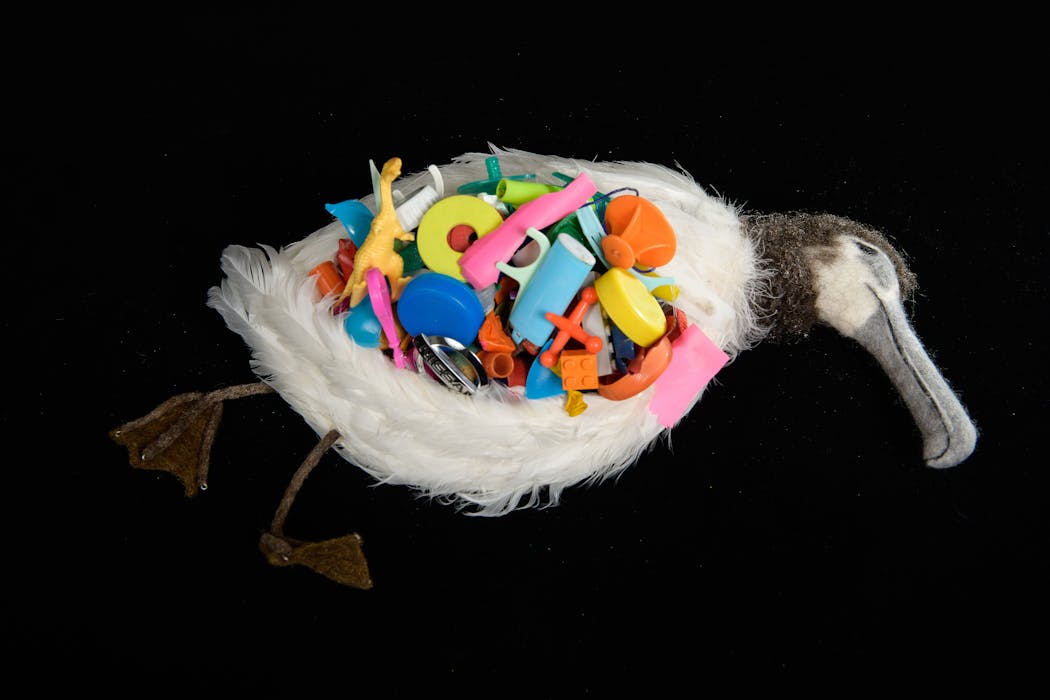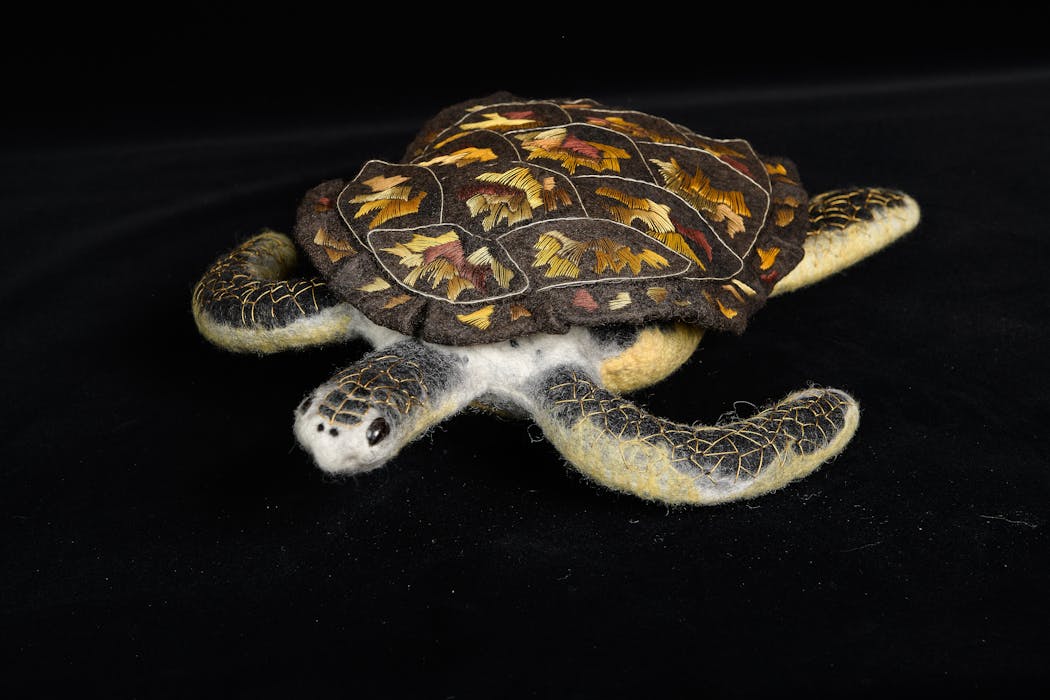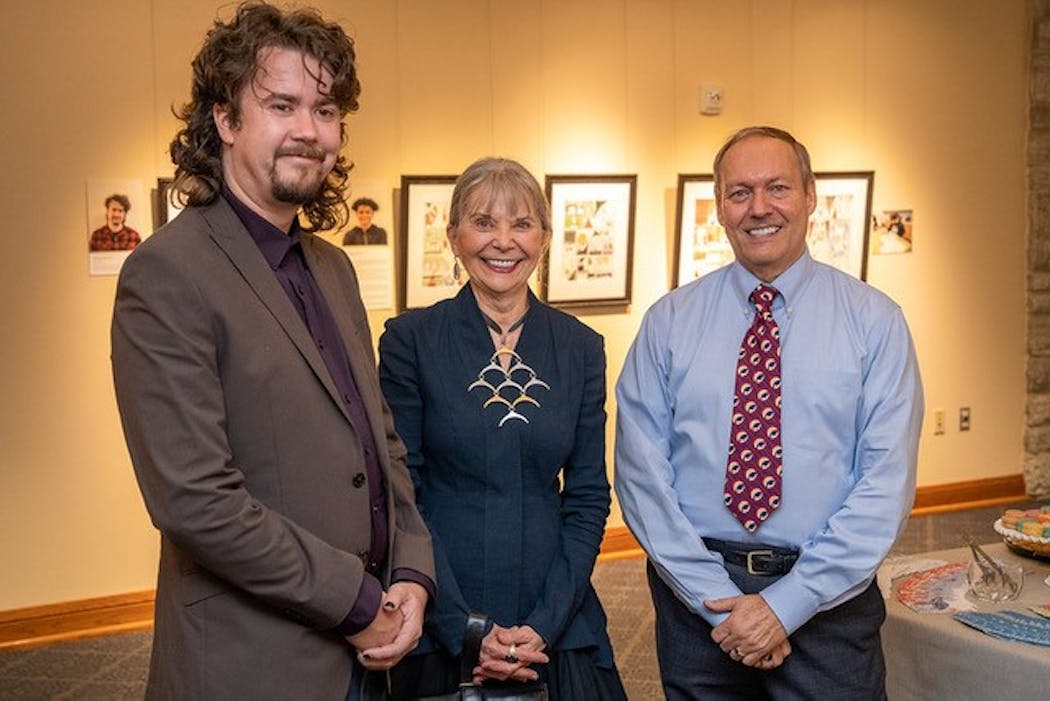These aren't the kind of stuffed animals you can cuddle up to. But you can enjoy their peculiar beauty — and, while you're at it, learn something about protecting the planet.
"Voices From the Water" is an exhibit of 21 brightly colored, anatomically accurate sea creatures sculpted from handmade felt. Created by Susan J Sperl, they're on display through Nov. 20 at the Westminster Gallery in Minneapolis, part of the gallery's 20th anniversary celebration.
The exhibit is about "the stories told by each sea creature about their role in maintaining the health of the ocean web," Sperl said. "Hence the title 'Voices From the Water.'"
The sculptures are crafted from felt that Sperl makes by mashing together strands of wool. Their vivid colors aren't just decorative choices; most reflect the creatures' natural pigmentation.
Labels alongside the sculptures describe how evolution has equipped them with diverse physiologies for eating, breathing and protecting themselves. The leafy sea dragon's leaf-like appendages, for example, provide camouflage amid sea vegetation. The Spanish shawl is covered with spiky projections that play a part in breathing and digestion and contain stinging cells for self-defense.
"They've survived because they've evolved some adaptive strategies," Sperl said.
The labels include fun facts: The chain catshark can emit green fluorescent light, the masked pufferfish can inflate itself to appear much larger. And be sure to direct your third-grader to the bumphead parrotfish, which makes its own protective sleeping bag from mucus (snot!) and excretes bits of ingested coral (poop!) in the form of sand that helps build tropical beaches.
But some touch on the grimmer topic of how the animals' existence is threatened by human activities.
Mola mola eat plastic bags, mistaking them for jellyfish. Hawksbill sea turtles' beautiful translucent shells — which Sperl used silk embroidery to suggest — make them a target of poachers, who use the shells for jewelry and accessories (illegal to sell or import in the United States and many other countries). Sawsharks have long, tapering sawlike snouts that get hacked off for souvenirs.
Easily the most sobering sculpture is Sperl's Laysan albatross, covered with real albatross feathers collected in California's Monterey Bay. She depicts it as a dead bird with its stomach cut open to expose more than half a pound of plastic items — cigarette lighters, bottle caps, tooth flossing picks, Legos — objects that actually are commonly found in the stomachs of suffocated birds.
Adult Laysan albatrosses, which mate for life and have wingspans of more than 6 feet, pick up the items when skimming the water for food and unwittingly feed them to their chicks.
You might want to point your third-grader to that one, too, for its lesson in environmental protection. But your kid already might know about it.
"I think children are getting the message and they're sharing the message already," Sperl said. "My neighbor down the block said her 5-year-old twins came home and started lecturing her on single-use-plastic purchases."
Millions of tons
Reducing plastic waste is a big priority for Sperl. The albatross sculpture is stuffed with items Sperl collected herself on her street in the Near North neighborhood of Minneapolis, where she's been picking up trash twice a week for 34 years.
Stormwater washes litter into the Mississippi, which in turn carries it into the ocean, where marine animals mistake it for food. An estimated 8 million tons of plastic a year enter oceans from rivers and land, harming more than 800 species.
"Stormwater picks up anything that's on the ground, whether it's garbage or fertilizer or road salt or leaves, which then goes into storm drains, which then goes into the river untreated," said Abby Moore, training and community learning specialist at the Mississippi Watershed Management Organization (MWMO).
To underscore the problem's local link, Sperl asked MWMO to organize an art class for students around the subject. Two of the students, Winter Crenshaw and Donte Beck, contributed work that's in the exhibit alongside Sperl's.
The idea was to get the youth to "think about things as simple as cleaning out storm drains and not littering, which can really make a difference," Moore said. "So it's not just you and me doing it, but all of our neighbors and all of our friends."
River pollution is not the only way plastic debris gets into oceans.
"One mind-boggling statistic, among many, is that a garbage truck full of plastic trash is dumped into the ocean every minute," Sperl said. Other items come from shipping containers; the World Shipping Council estimates that on average 1,382 containers — each holding thousands of pounds of products, including plastic — fall off ships and into the water every year.
Sperl has been recycling plastic for decades but has come to realize that's not enough. Studies show most recycled plastic doesn't actually get reused in new products, although Minnesota is better than most places at recycling effectively.
So experts emphasize reducing and reusing plastic. Hennepin County offers several types of "Zero Waste Challenges" to help individuals and households learn to reduce plastic and other waste.
Sperl says she's "chipping away at it." She uses refillable bottles for shampoo, detergent and other supplies. She buys natural-fiber clothing from consignment and thrift stores. She carries her own plastic lids and utensils into coffee shops. Recently she called the manufacturer of her favorite tortilla chips and asked them to stop using plastic packaging, but was told plastic was necessary for shipping purposes.
"So I'm going to stop buying them," Sperl said, a little sadly.
Interconnected life
Sperl's interest in ocean life began when her daughter gave her a book of marine portraits called "Fish Face" by underwater photographer David Doubilet.
"'Fish Face' was sort of my jumping-off point," Sperl said. She has now amassed 185 sea-creature books, including coffee-table books of photographs she studies to craft her sculptures.
Although each of her sculptures is a distinct piece of art, when discussing marine life she likes to emphasize creatures' connectedness.
"I'm getting some peace and comfort in thinking about the bigger picture," she said.
In addition to eating each other, the animals form symbiotic relationships. The parasites that encrust the mola mola (Sperl depicted them with beads) are in turn fed upon by cleaner fish and seagulls. And humans, whether we realize it or not, are part of the system, Sperl said.
"The air we breathe, the water we drink, the food we eat are made possible by the ocean," she said. "If one is affected, there's a ripple effect — pun intended."
Judge declines to dismiss lawsuits filed against rapper Travis Scott over deadly Astroworld concert

Summer Movie Guide: Virtually all the movies coming to theaters and streaming from May to Labor Day








